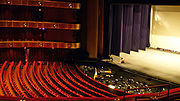
Orchestra pit
Encyclopedia

Theater (structure)
A theater or theatre is a structure where theatrical works or plays are performed or other performances such as musical concerts may be produced. While a theater is not required for performance , a theater serves to define the performance and audience spaces...
(usually located in a lowered area in front of the stage
Stage (theatre)
In theatre or performance arts, the stage is a designated space for the performance productions. The stage serves as a space for actors or performers and a focal point for the members of the audience...
) in which musicians perform. Orchestral pits are utilized in forms of theatre that require music (such as Opera
Opera
Opera is an art form in which singers and musicians perform a dramatic work combining text and musical score, usually in a theatrical setting. Opera incorporates many of the elements of spoken theatre, such as acting, scenery, and costumes and sometimes includes dance...
and Ballet
Ballet
Ballet is a type of performance dance, that originated in the Italian Renaissance courts of the 15th century, and which was further developed in France and Russia as a concert dance form. The early portions preceded the invention of the proscenium stage and were presented in large chambers with...
) or in cases when incidental music is required. The conductor is typically positioned at the front of the orchestral pit facing the stage.
In marching ensembles such as drum and bugle corps
Drum and bugle corps (modern)
A drum and bugle corps, also known as a drum corps, is a musical marching unit consisting of brass instruments, percussion instruments, and color guard. Typically operating as independent non-profit organizations, drum corps perform in competitions, parades, festivals, and other civic functions...
, the pit refers to the front ensemble
Front ensemble
In a marching band or drum corps, the front ensemble or pit is the stationary percussion ensemble. This ensemble is typically placed in front of the football field, though some groups will work the front ensemble into a tight pod onto the marching field...
, a section of stationary percussion instruments located at the front of the performance area.
Construction
Typically, orchestral pits are located in the auditoriumAuditorium
An auditorium is a room built to enable an audience to hear and watch performances at venues such as theatres. For movie theaters, the number of auditoriums is expressed as the number of screens.- Etymology :...
directly in front of the stage. They are sometimes capable of being lowered in order to keep the musicians out of the sightline
Sightline
A sightline, or sight line, is a normally unobstructed line-of-sight between an intended observer and a stage, arena, or monument, for example. Sightlines are a particularly important consideration in theatre and stadium design, road junction layout and urban planning...
s of the audience
Audience
An audience is a group of people who participate in a show or encounter a work of art, literature , theatre, music or academics in any medium...
. In some cases, part or all of the pit sits on a mechanical lift
Elevator
An elevator is a type of vertical transport equipment that efficiently moves people or goods between floors of a building, vessel or other structures...
which can raise the floor to the level of the stage deck. Often an orchestra pit will be equipped with a removable pit cover which provides safety by eliminating the steep drop off from the stage and also increases the available acting area above. In most cases, some sort of lattice or sound port is built into the front of the orchestra pit, to allow audience members in the front rows to hear the music while retaining a wall which separates them from the orchestra.
The size and design of an orchestral pit can vary greatly. In performances of Operas, especially those of Richard Wagner
Richard Wagner
Wilhelm Richard Wagner was a German composer, conductor, theatre director, philosopher, music theorist, poet, essayist and writer primarily known for his operas...
, the pit may need to be increased in size to accommodate the large orchestra required. In performances of musical theater, orchestral pits are typically small as there is no need for a larger one. Some theatres have flexible pit configurations, allowing extra audience seats to be added in place of all or part of the pit according to the size of the orchestra being used for a particular production.
See also
- Musical Theater
- OperaOperaOpera is an art form in which singers and musicians perform a dramatic work combining text and musical score, usually in a theatrical setting. Opera incorporates many of the elements of spoken theatre, such as acting, scenery, and costumes and sometimes includes dance...
- OrchestraOrchestraAn orchestra is a sizable instrumental ensemble that contains sections of string, brass, woodwind, and percussion instruments. The term orchestra derives from the Greek ορχήστρα, the name for the area in front of an ancient Greek stage reserved for the Greek chorus...
- Pit orchestraPit orchestraA pit orchestra is a type of orchestra that accompanies performers in musicals, operas, and other shows involving music. In performances of operas and ballets, the pit orchestra is typically similar in size to a symphony orchestra, though it may contain smaller string and brass sections, depending...

